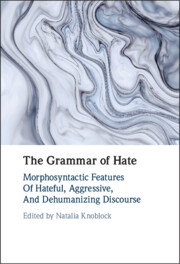Book contents
- The Grammar of Hate
- The Grammar of Hate
- Copyright page
- Contents
- Figures
- Tables
- Contributors
- Acknowledgments
- Introduction
- 1 Animacy and Countability of Slurs
- 2 Language Aggression in English Slang: The Case of the -o Suffix
- 3 Adj+ie/y Nominalizations in Contemporary English
- 4 Grammatical Gender and Offensiveness in Modern Greek Slang Vocabulary
- 5 Unseen Gender
- 6 The Neutering Neuter
- 7 Neutering Unpopular Politicians
- 8 The Power of a Pronoun
- 9 Is Play on Words Fair Play or Dirty Play?
- 10 Expressive German Adjective and Noun Compounds in Aggressive Discourse
- 11 ‘Kill the Invaders’
- 12 ‘I am no racist but …’
- 13 Homophobic Space–Times
- Index
- References
1 - Animacy and Countability of Slurs
Shifting Grammatical Categories
Published online by Cambridge University Press: 30 June 2022
- The Grammar of Hate
- The Grammar of Hate
- Copyright page
- Contents
- Figures
- Tables
- Contributors
- Acknowledgments
- Introduction
- 1 Animacy and Countability of Slurs
- 2 Language Aggression in English Slang: The Case of the -o Suffix
- 3 Adj+ie/y Nominalizations in Contemporary English
- 4 Grammatical Gender and Offensiveness in Modern Greek Slang Vocabulary
- 5 Unseen Gender
- 6 The Neutering Neuter
- 7 Neutering Unpopular Politicians
- 8 The Power of a Pronoun
- 9 Is Play on Words Fair Play or Dirty Play?
- 10 Expressive German Adjective and Noun Compounds in Aggressive Discourse
- 11 ‘Kill the Invaders’
- 12 ‘I am no racist but …’
- 13 Homophobic Space–Times
- Index
- References
Summary
The study highlights semantic, syntactic, and functional features of two novel slurs that have recently entered the Russian and Ukrainian languages as a result of the Ukrainian crisis. The words ukrop (dill) and vata (cotton wool) underwent a semantic shift and acquired new negative meanings which can now be used to refer to the opposing groups in hostile communication. The chapter highlights semantic aspects of the words ukrop and vata that make them particularly suitable for use in dehumanizing metaphors, but the main focus of the study is the grammatical changes ukrop and vata underwent as a result of the semantic shift. Used in their traditional senses, both nouns function as uncountable, mass, inanimate nouns. However, novel uses of these words as slurs prompt some unconventional grammatical structures. For example, vata now demonstrates some non-standard subject-verb agreement patterns, and ukrop is sometimes used as a countable noun when it refers to people. Ukrop, used in its new sense, is also moving from the inanimate to the animate noun class. This discussion of the deviations from the grammatical norm expands into a conversation of the connections between the linguistic changes these words are undergoing and extralinguistic context of their use.
- Type
- Chapter
- Information
- The Grammar of HateMorphosyntactic Features of Hateful, Aggressive, and Dehumanizing Discourse, pp. 15 - 33Publisher: Cambridge University PressPrint publication year: 2022



